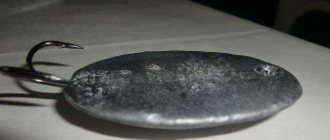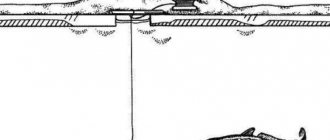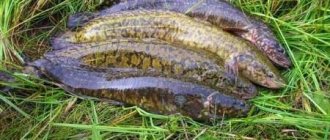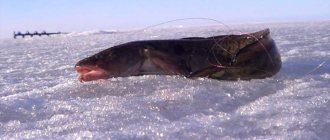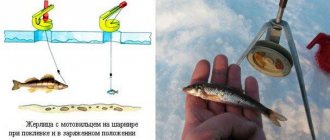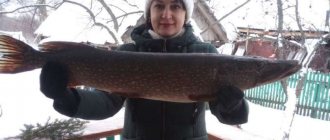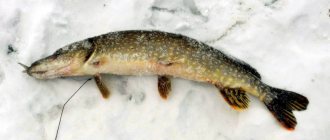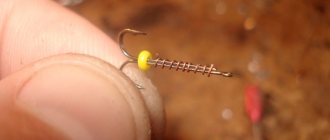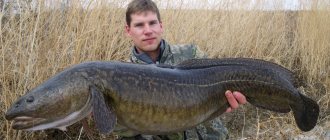Tender, slightly sweet-tasting burbot meat will not leave anyone indifferent. Since this fish is the only representative of the cod-like order that lives in fresh water, it is valued even more highly.
Burbot is widespread throughout almost the entire territory of Russia. It prefers rivers, lakes and reservoirs with clean, cold water.
The fish stays near the bottom, looking for natural shelters from snags, sunken logs, intertwined tree roots, sand pits, clay ledges and between stones.
Burbot spawns in the middle of nowhere. It lasts about two weeks, during which the fish loses a lot of weight, as it forgets to eat in a timely manner.
At other times, burbot is a very voracious predator that chooses to hunt at night. His favorite delicacies are small fish and amphibians like frogs, and the eggs of other fish during the spawning period in early spring.
Some particularly well-fed individuals can reach 1 meter in length and up to 20 kg in weight. For any fisherman, burbot is a welcome “gift” and worthy compensation for the time spent catching it.
Since burbot likes colder water, it begins to be active closer to mid-November. In summer, the fish hides at the very bottom, looking for places with weak currents where the lowest water temperature remains.
The period of winter fishing for burbot using girders starts immediately after freeze-up.
Where and what do they use to catch burbot in winter?
Burbot is a fish that is not caught on common artificial baits. Catching burbot in winter using girders, which are a stand with a flag, is carried out using live bait. Even dead fish are suitable as live bait. The predator actively begins to peck when cold weather sets in. It is found in large quantities in the Volga, Lena and other rivers of Siberia. It is less common in other reservoirs. It differs from other fish in its tasty meat, from which you can prepare rich fish soup.
They start fishing in January. The following are used as live bait:
- dead fish;
- pieces of large fish;
- crawl out.
How to make a zherlitsa or a stand with your own hands
Over all these years, fishermen have not only made, but also developed a lot of homemade girders. This is especially true for those for whom traveling to the nearest fishing store still causes some difficulties.
There are a lot of designs, from ordinary “butts” to cunning devices. Yes, the simplest homemade zherlitsa is a “poke”, made right in nature:
- Take a long stick and sharpen the end with a knife.
- The equipment is attached to the lower part.
- The upper part of the stick is equipped with some kind of landmark (an orange ribbon, for example).
This version of the “postavushka” is stuck into the ground (hence the name) so that 50 centimeters remain sticking out. And it’s easy to get, and you won’t lose the hole. More like a country way. In general, a “supply” is an under-ice vent, which we can leave to freeze, and come back the next morning and check the equipment. A hole is drilled nearby and the fishing line is taken out with a wire hook. Let's make such a girder with our own hands:
- We take something oblong and sinking. For example, a piece of hose 30 cm long.
- A hole is made in one side of it and a cord is inserted there.
- They stuck one end through, pulled it back, made 5-6 turns on the reel, and stuck it through again.
- A locking stick (necessarily strong) is tied to this end. Let there be 50-60 cm from the reel to the stopper.
- The cord is wound onto the hose so that the full supply of fishing line is 10-15 meters. We fasten the equipment.
- A little lower you can make a cut (right on the wall of the hose) to insert the fishing line there - a kind of retainer.
- The burbot will bite - the reel will unwind, and the stopper will not allow our “post” to be dragged under the ice.
A homemade “circle” type girder is also easy to make, but you can’t do without a factory reel (from the same fishing line):
- Take a piece of plywood and cut out a square. It’s not necessary to make a circle, right? If only the base was wider than the hole.
- We make a hole in the center, at least 20 mm in diameter, not critical.
- A cut is made from the center to the side to insert the fishing line.
- Take a steel strip. Holes are drilled at both ends, one end is bent to form a corner.
- The bent end is attached to the base (a bolt and a nut, preferably a wing nut), and a coil is placed on the other.
- Everything is connected, you can put a small bolt on the wall of the reel - a handle for winding.
- Take a rigid cable tie, where the head is - this is the connection point with the “circle” (with a screw to the plywood), the other end - we attach a flag to it. The result is a flagpole, it should bend exactly under the coil.
You can make a zherlitsa, using your own imagination, from anything. What kind of improvised means are used! Make it yourself or buy it – the choice is yours, but, in any case, be careful on the ice, take care of yourself and good luck with your fishing!
Advantages of using girders
The main means of fishing is a store-bought or home-made girder designed for catching pike. It is attached to the hole, and when there is a bite, the flag signals the presence of fish on the hook. The design of the gear varies. The simplest one is called a postavushka. It can be made from available material directly at the site where the predator is caught. To do this, you need a stick slightly longer than the diameter of the hole and a spear tied to it.
The advantage of the gear is that the fishing tackle for catching burbot on a girder in winter is installed in a drilled hole with the spear pointing down. It does not freeze in water and remains operational all night. If you find the desired depth by trial and error, then the fishing line needs to be fixed to the spear.
Fishing tactics
Winter is the period of activity for burbot. At this time, the remaining fish go into suspended animation. The colder it is, the more active the burbot behaves. As the weather gets warmer, the bite becomes less active. The predator bites at night and during the day.
This is explained by the fact that it is a cold-loving fish. It is impossible to distinguish day from night under the ice. Winter fishing for burbot on girders turns out to be more effective in the intervals between 21 and 24 hours, as well as from 3 to 5. At these hours, according to experts, the burbot begins to actively feed.
The tackle is lowered into the hole, which is covered with a piece of plywood and covered with snow. A mark is placed nearby to serve as a guide during the morning search for an ice hole with a vent. It is recommended to check the vent after a few hours, since the flag does not always work.
The peculiarity of the predator is that, having caught prey, it remains in the same place and eats it right there. If the food turns out to be live bait, the burbot puts itself on the hook. It is not always possible to get it, so you need to have spare hooks.
How to properly set up a burbot fishing rod
So, let us immediately note that the tackle is distinguished by its simplicity of design, as well as maximum reliability. The simplest design consists of a reel on which the main fishing line is wound, the edge of which is tied to a block. The reel is located under the ice, and the block is located above the hole. After the bite, the supply of fishing line is released freely, which eliminates the possibility of the gear breaking. Note that it is enough to leave only 2-3 meters of fishing line. Such designs are rarely used today, due to the fact that the tackle can be bought ready-made at a fishing store.
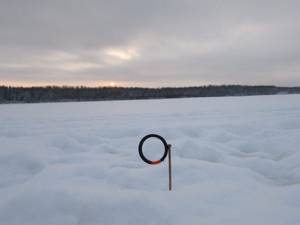
Modern designs of girders consist of a stand, a reel on which a supply of fishing line is stored and a bite alarm. The presence of such equipment will allow you to catch pike during the day, and at night, without changing anything in the equipment, you can catch burbot. The only thing that distinguishes the girder for pike and burbot is the presence of a metal leash in the first case.
A burbot fishing rod consists of a stand, a reel with a small supply of fishing line and an alarm. The main fishing line is selected with a cross-section of 0.4 mm, the load is relative to the weight based on the fishing conditions, namely the strength of the current. The tee is attached directly to the main line; the leash does not need to be used. Note that it is rarely possible to remove a hook from a burbot, since it swallows the bait deeply, so it is recommended to stock up on a large number of hooks, which after the bite will be tied to continue fishing.
As for bait, it is best to use live and fresh fish (goby, ruffe, gudgeon) for fishing. If you cannot get the marked fry, then a roach or bream will do. During the peak of the predator’s activity, it can be successfully caught using cut fish. Burbot reacts reluctantly to rotten baits. Lures such as worms and frogs, which are popular in the fall, are not suitable for winter fishing.
Features of winter fishing for burbot using girders
Winter fishing for river predators turns out to be an interesting and profitable activity. For successful fishing, it is important to choose the right place, set up a trap with bait and wait. It can be difficult to do this on an unfamiliar body of water, but it is possible. It is best to use live bait as bait, because the bait must move actively.
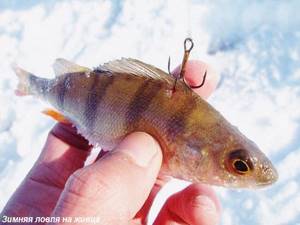
What does the tackle consist of?
A fishing rod for catching burbot in winter can be made in a few minutes. To do this, you need to take a wooden stick slightly longer than the diameter of the hole. Tie a slingshot to it with a fishing line wound around it. The length of the fishing line depends on many reasons, but it should be at least 10 m. At the end of it there is a hook with live bait. The predator catches the bait, the line unwinds, and the burbot puts itself on the hook.
Catching predators is not always done with ordinary girders. You can build a bun. It consists of the same stick, which is laid across the hole. A reel with a piece of fishing line is tied to it. There is a split in it for fixing the fishing line.
When biting, the line is freed from the split and the fish is placed on the hook. The reel used to be made of wood, today you can use a plastic bottle. It can have different sizes. The main thing is to fulfill your functions. Such a structure can be kept on the hole all winter.
The poke is done a little differently. A fishing line about 2 m long is tied to a pole, which is stuck into the bottom of the reservoir. The fishing line is equipped with a sinker and a hook on which the bait is attached. Kolobashka and poke are often used by fishermen who use permanent fishing spots.
It is recommended to tie a strong hook, with a sharp tip and a long shank. The weight of the sinker is chosen depending on the size of the live bait. The sinker should lie on the ground, occasionally rising above the bottom and falling back. The rising turbidity attracts burbot. It is enough to make a leash 50-60 cm long. The bait for fishing on such a leash actively moves, but does not float away anywhere.
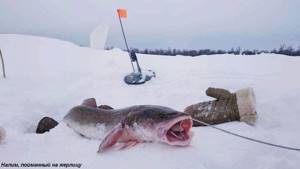
Bait in the form of a loach, ruffe, or other small fish is placed behind the back. In their absence, fry of any breed, shrimp, and pieces of liver are added.
Choosing an installation location
The main winter fishing takes place when there is a lot of snow and severe frosts. When choosing a fishing spot on an unfamiliar body of water, you have to drill many holes in order to install more girders with equipment. Some areas have gear restrictions, so you need to know this in advance.
An ice hole with a successful bite should be located above a path or other place where predators gather. If you first measure the depth, then the fishing line needs to be fixed. The holes are drilled at a distance of several meters from each other. They can be placed 10-20 m apart in a checkerboard pattern, in the form of a semicircle, a straight line and in other ways.
Burbot loves depth, especially in winter frosts. Catching it with a bait is an effective way of hunting. He moves along the same paths. Their width is about 1 m. Finding trails means providing yourself with fish for many years.
Drilling holes and installing vents
The burbot bite lasts all winter. Burbot spawns in December and January. During this period, he briefly refuses to eat. The spawning period depends on weather conditions and the nature of the reservoir. When the water warms and its temperature reaches +10˚С, hunting for burbot in winter temporarily stops. It hibernates until frost sets in.
To install the girders, it is necessary to drill many holes in the ice. They are arranged in a zigzag or straight line, in an arc or in a checkerboard pattern. The choice of scheme depends on the location of the fish sites and the bottom topography. A hole in the right place can produce a good catch. There is no point in using other holes in the ice. It is best to cover the ice hole with the ice hole installed with a piece of polystyrene foam or prepare an ice pick for cutting through ice.
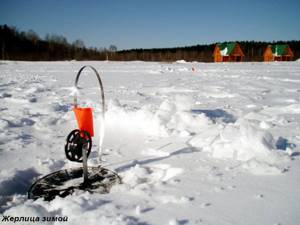
It is advisable to install the girder above the path along which the fish moves. Burbot chooses deep places or changes in depth, currents near the bottom and natural shelters. It is attracted to sandy, pebble or rocky bottoms. Favorite habitats on rivers are steep banks and river mouths.
You need to attach the live bait from the back, leaving the tip of the hook clean and open. This position of the hook allows the bait to move actively and attract the attention of a predator.
Checking gear
Winter fishing for burbot using baits is most often done in familiar places according to a pre-thought-out scheme. They are checked after a few hours. If frequent bites are observed in several neighboring holes, all gear must be moved to this square.
Biting and fishing
The burbot bites specifically. It creeps up on its prey slowly, then pounces on it and swallows it. After setting, it does not float away; it remains in place until the fish stops fluttering. It’s too early to hook him at this time. After unwinding all the fishing line, you need to make a short jerk and start fishing for prey. They do this quickly so that the fish does not have time to hide in the snags. After fishing, it is recommended to stun the fish with a blow to the head with a stick. It is difficult to catch a predator using other methods.
Gear device
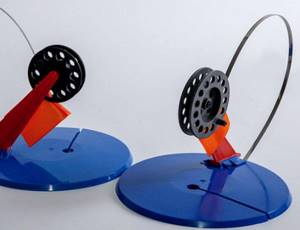
Zherlitsa is the general name for winter live bait gear. It is designed for catching predatory fish from under the ice. It is a reel or reel with fishing line. To register bites, a bright-colored flag is used, which, after contact of a predator with the bait, “shoots”, signaling this.
There are different designs of vents. The choice of pattern depends on the fishing conditions, the subjective preferences of the fisherman and his capabilities, and the fishing region. With a skillful approach, any option works, showing stable results throughout the “hard” water season.
Equipment for vents
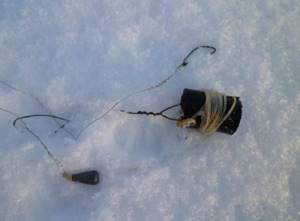
It is not difficult to properly equip a burbot perch. To do this, you need a piece of fishing line with a hook to deliver live bait to the fishing point and a sinker to fix it at the bottom. The branch is made from monofilament or fluorocarbon fishing line with a thickness of 0.3–0.5 mm with a breaking load slightly less than the strength of the main thread.
Advice. If there is a high probability of a pike biting in the fishing area, then it is advisable to use a leash made of steel string or a woven metal outlet to prevent the equipment from being cut off when the toothy beast grabs.
Use a large double or single hook. Burbot swallows bait deeply, so using a tee is not necessary. It is unlikely that the fish will escape while playing, but pulling it out of the predator’s stomach will not be easy.
The shape and weight of the weight are selected according to the fishing conditions. In the current, use flat or conical weights with a mass sufficient to hold the bait under the hole. On a standing body of water, the bait must be equipped in such a way as to prevent the equipment from sinking to the bottom and to prevent the live bait from moving it from its place.
We recommend reading: The most catchy wobblers for asp
What to use as bait
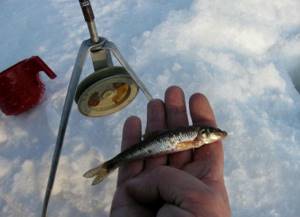
To catch burbot on a girder, you need fresh and lively bait. To do this, they use small bottom fish, which are the natural food source of the predator in the reservoir. Has proven itself well:
- goby;
- gudgeon;
- ruff;
- perch;
- loach;
- pinching
If they are absent, a silver bream or white bream will do. Roach, bleak, redfish and other fish that live in shallow water and in the upper horizons are not suitable for fishing for burbot. As a last resort, it is allowed to use fallen live bait, sliced fish fillets, fresh frozen shrimp or a piece of liver.
What is the best live bait for burbot?
So, girders are a productive method of catching predators that are difficult to deceive with a spoon. Burbots do not refuse live food. Therefore, winter fishing for burbot is considered an exciting process that brings good trophies. The best bait can be:
- live bait;
- pieces of liver, meat, fish;
- crawl out;
- frozen fish.
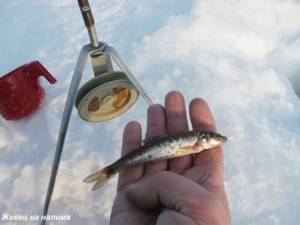
The best bait is live bait. It attracts predators with its smell and movements. Juvenile fish of the following breeds can be used as it;
- ruff;
- gudgeon;
- perch;
- chebak.
Also suitable:
- shrimps;
- worms;
- pieces of large fish;
- dead fish.
How to place the girders
When a place has been chosen, you can start setting up girders and fishing it. Near deep holes, you need to place it a little higher upstream, 5-8 m. Ice holes should be made at a distance of several meters from each other. When the ice is thick, it is easier to drill a hole with an ice drill. The diameter is approximately 30 by 30 cm, which is quite enough to pull out an individual weighing several kilograms.
It is worth tying several leashes to the girder itself: one is tied to the sinker, and the second is a little further. If the live bait stops actively moving, the current will touch the upper leash and force it to move. Also, this will allow you to catch several fish at once, if you're lucky.
Advice! It is better to knit a leash from a strong fishing line 0.6 mm in diameter, with a small loop at the end. The length of the lower leash is 60 cm, and the upper one is 10-15 cm shorter.
It is very important to put on your live bait correctly to avoid damaging it. To do this, a loop of the leash is passed into his mouth and pulled out through the gills. Overlapping, through the eye, doubles are threaded, which are attached to the lower fin of the baitfish. This method allows the bait to move actively and live much longer, attracting a predator with its movements.
How to avoid basic mistakes?
Burbot fishing takes place in winter, during the cold season. You shouldn’t rely on catching burbot in December with girders in winter. They will remain empty, especially at the beginning of the month. The end of December and the beginning of January is the period of active spawning of the predator. At this time he refuses any food. You need to catch it in bad weather and in extreme cold. It is difficult to catch him during the day, because he usually leads a nocturnal lifestyle. The predator is especially active from 21:00 to 1:00 am and from 3:00 to 5:00 am.
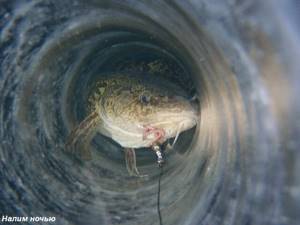
The most catchy holes will be those drilled above the path of movement or above the fish collection area. You should look for these places at differences in depth: next to underwater holes, near gentle shores. It is recommended to place the traps at night at a distance of 5-8 m from the pits upstream of the river. You need to drill a hole approximately 30 cm in diameter. This will make it possible to pull out even large fish.
It is worth tying several leashes to the harness. Live bait will set them in motion, which can attract several specimens of prey.
Beginner mistakes
The first mistake I would like to make is the use of a thin ice drill. When biting a large specimen, problems immediately begin when the burbot “turns over” while fighting with the fisherman. It’s better to immediately purchase a wide drill, whether you want an imported model or a domestic ice drill. Personally, I have Barnaul, I’m not complaining, I always have inexpensive knives in stock.
Even beginners usually fail to catch burbot if they fish incorrectly; as they say, they are caught in the “stupid” game. You can’t do this; you have to pull it out quickly, but at the same time, carefully. They often forget to cover the hole when fishing, shining a flashlight directly into the water - the same thing, I only burbot “on hand”. You shouldn’t make any noise when hooking either; some people immediately begin to rejoice: “Oh! He’s biting, I’m dragging him, I’m dragging him!” It’s better not to scare the predator again.
Then there’s the situation when, it seems, you’re doing everything right, but the burbot doesn’t bite at all. Most likely, the angler decided to go fishing during the spawning season. You know, burbot does not feed, but it turns out that it eliminates any threat to its eggs! He does it like this: he swims up to the live bait and presses it into the ground with his head - he simply kills it, at this moment the girder may work, but there is no one there. Only fish.
In general, the “weakest link” of beginners is poor preparation for night fishing. You need to take everything you need with you, because you will have to walk, check, install, and all this in bad weather.
